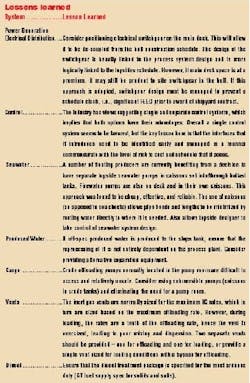DEEPWATER E&P: Part II: Understanding the risk of innovation in deepwater concepts selection
Richard Snell, Hugh Banon
BP Upstream Technology Group
PART II: This is Part II of a two-part series on deepwater concept selection and risks. Part I appeared in the March issue.
For shallow water developments, the industry has made steel piled jackets (SPJs) the conventional development option. In many areas, considerable effort has also been expended in standardization of SPJs to minimize the design effort, construction time, and costs. Therefore, concept selection is a relatively straightforward effort in the case of shallow water developments.
For deepwater developments, there is not yet a standardized list of concepts for all combinations of water depths and field development requirements. This lack of standardization is partially a reflection of lack of maturity of the deepwater arena - the established deepwater concepts such as tension leg platforms (TLP) and spars are still being studied to extend their application beyond their existing boundaries while there are other concepts at various stages of development.
Therefore, one may conclude that a concept selection process should be an integral part of a deepwater development. Ironically, economic pressures on the industry often push the project teams into skipping or limiting their concept selection process. This is a decision that can have serious impact on the eventual economics of a field.
There are several factors that can affect the selection of a concept for a deepwater field. The most important are:
- Dry trees versus wet trees
- Oil storage requirements
- Number of wells
- Location of wells - a single cluster of wells or distributed
- Frequency of well intervention
- Water, gas, and cuttings injection well requirements
- Proximity to existing infrastructure
- Water depth, ocean conditions, and geohazards
- Installation weather window
For dry-tree concepts, the important factors in a concept selection are: water depth, number of wells, tension requirements of top tensioned risers, topsides payload and surface area, and the requirement to use a subsea blowout preventer (BOP) stack versus a surface BOP stack.
For wet-tree concepts, a floating vessel can act as a hub for processing of hydrocarbons and exporting processed oil or gas. In this case, the important factors in a concept selection are: requirement to access the wells from the vessel, effect of vessel motions on steel catenary riser or hybrid riser design, and topsides payload and surface area.
Concept maturity
Maturity is a combination of several issues that during concept development will be defined to varying degrees of completeness. A floating concept consists of a number of sub-components, which have to be designed in the context of the specific field requirements. The switch from a concept being considered immature to mature is a combination of factual data and perceptions on each sub-component as well as the totality of the system.
Full maturity is when several examples have been built in more than one yard and the lessons learned are well documented. Defining an adequate level of maturity for a project is difficult. The figure reflects the regional and water depth maturity of different deepwater concepts. Technical maturity may be gauged based on:
- Research and development on significant items completed
- Demonstrated ability to predict the motions and global forces in the hull, riser, and mooring system
- Well systems and interface with deck equipment defined
- Practical and appropriately safe topsides layout defined
- Hull and key component integration defined
- All major components designed and manufacturing requirements understood
- More than one engineering company having a sound understanding of the technical requirements needed to implement the design
Commercial maturity may be gauged based on:
- Hull and hull component detailed design and build methodology understood
- Major component (risers) detailed design, build, and installation methodology understood
- Availability of yards with skills, facilities, and capacity for building the particular hull form
- Plan for division of work between hull and topsides yards and topsides installation
- In-field installation methodology defined
- Detailed understanding of how a concept compares with prior built concepts and construction solutions for new items
- Realistic cost estimate and schedule with adequate contingencies for any new items
- Lessons learned from prior examples
Managing technical risks
A floating concept is a system with highly coupled subsystems, so interaction effects are much more complex than for a fixed structure. Mature concepts have been developed to the point where interactions among subsystems or components are understood, and more than one vendor has the capability of supplying the design of "standard" components.
For novel floating concepts, particularly for the immature concepts, significant design development is needed for major sub-components and often this work takes place with just one vendor. In the following, we focus on components, interactions, and subsystems that have the most significant technical impact on the design of a floating vessel.
Developing adequate technical details and definitions in the topics below is the key to managing the technical risks of a novel floating vessel concept. For mature concepts, these issues have been developed over several units, while for novel concepts technical feasibility can be proven only after rigorous design leads to detailed definition.
- Hull motions and global forces prediction: The classical method of designing a new deepwater system is to develop the outline design by calculation, undertake progressively more detailed calculations as the design develops a balance between the competing needs of subsystems (most often governed by risers and riser tensioning), and perform model test to validate and calibrate the analytical motion predictions. The model tests, being expensive, are often in two stages. Proof of concept is performed at an early stage, and full concept validation is performed at a stage when major component designs are nearly finalized.
- Interface with drilling: A floating facility that has drilling and workover capability will have a high degree of interaction with the drilling equipment (the drilling rig, drilling equipment, the blowout preventer stack, and the drilling riser), which can all significantly affect the design of the floating vessel. Not all of the present floating concepts can accommodate the full range of drilling requirements in very deep water.
- Interface with risers: Production risers from subsea wells may be co-mingled or individually flowed to the surface facility through steel catenary risers (SCRs) or hybrid risers. Dry tree concepts depend on an array of top tensioned risers (TTR). In both cases of SCRs or TTRs, the offset at which the risers retain integrity governs the mooring design. The mooring design has to cope with both installation phase, when only a single riser may be deployed and operating when all are in place, thus the design cannot count on the very considerable restoring force of the risers in mooring design. In addition, the design has to cope with the change in heave natural period of the vessel due to varying numbers of risers during the field life.
- Hull integration with topside: The topside designers are rapidly learning the differences between fixed structure topsides and the needs of one designed for a floater. Potential aspects of floater design, such as single level layouts, motions that govern the process and power generation design, deck flexure, and the requirements of marine classification all result in a different set of design parameters to conventional fixed platforms.
For safety and operational reasons, the control of production and the marine (ballast, cargo pumps, etc.) systems in a production vessel may have to be integrated. The degree to which the systems should be integrated (beyond the minimum necessary) is a key project decision.
Managing project risks
Some of the more important project risks faced in the application of deepwater floating concepts and proposes potential mitigations is a high degree of dependency between technical and commercial risks. Technically flawed designs that have to be fixed later during the facility's life can become a commercial disaster for the owner.
On the other hand, a commercial decision that is simply based on lowest costs may also lead to a floater with technical problems that cannot be used to fully extract the resources. The key to successful management of innovation risks is to consider commercial and technical risks, their inter-dependencies for the project and the lessons learned in previous developments.
- Contingency planning: In the design phase, a very thorough evaluation of what might go wrong and the economics of risk-mitigation options should be undertaken. It is in the nature of our industry to aim for earliest production as it is a significant component in field economics, but realism requires that for a first application, the field be shown to be robust with a 25% contingency in both schedule and costs. Pre-investment in studies prior to a project is the key to risk mitigation, but they have to be very detailed to justify eliminating contingencies in design and fabrication.
- Hull build: The recent record of the industry in obtaining sophisticated floating systems delivered to cost and schedule has been patchy. Even the drilling contractors who used to have a very good record have found it difficult to maintain that performance with the latest generation of very sophisticated deepwater drilling units.
- Fabrication details: An obvious but not so often used means of limiting risk is to develop a new design using fabrication details from existing concepts. Possibly lower structural efficiency may result in a heavier hull structure, but fabrication is significantly more expensive than steel supply, and the reduction in costs and schedule risk may more than outweigh any efficiency loss.
- Topsides integration: Integration of the hull marine systems with production systems is a frequent source of difficulty for floating vessels. The optimum efficiency (theoretically) ought to be maximum integration of the production and marine systems, all installed at the hull fabrication yard. Most shipyards are organized for sequential build of marine hulls with comparatively limited outfitting and limited use of exotic materials. The yards do not have the project management organization required to handle very sophisticated topsides integration. A number of high profile delays have occurred as a result of asking shipyards to undertake work outside their normal activity.
- Topsides installation: Most deepwater floating facilities have very substantial prod-uction throughputs and accordingly large and complex topsides. Topsides hookup and commissioning is expensive, and our experience from fixed platforms has shown the value of maximum completion prior to going offshore. For deepwater facilities, which are often some distance from infrastructure, this logic is further reinforced. Offshore topsides installation requires marine transport of equipment and men, which no matter how carefully planned, is more costly, more complex, and prone to schedule risks than operations alongside a quay. These risks are coupled with other regional issues.
For example, harsh conditions in the West of Shetlands may eliminate any deepwater concept that requires a long installation weather window. Also, the frontier regions such as West Africa may be better served by concepts that do not require a high degree of mobilization of installation support vessels.
- Self-installation and floatover topsides: Offshore installations are expensive by their nature, furthermore, installations in a remote location requiring lengthy mobilization of support vessels can be very expensive. Unique offshore installation support items, like heavy lift cranes, can, under some circumstances, become unavailable due to delays or mishaps in prior contracts. Schedule risks can be reduced by limiting the specialized support vessels required for installation.
Future concepts
The industry has a relatively short history of production in deepwater. It is also becoming evident that the future growth of offshore oil and gas will be in deeper waters. This trend is pointing to an urgent need to expand the existing toolkit of concepts to give operators more options, reduce the current costs and schedules, and make the relatively small deepwater fields commercial.
There are several steps that the industry, or operators, can take to advance the innovative solutions for deepwater developments. Two of these options are:
- Pre-investment: Pre-investment prior to a specific project in design feasibility, main sub-component development, model testing and fabrication planning studies is a very effective means of controlling risk, but care has to be taken to ensure that the studies are sufficiently comprehensive to identify and resolve all aspects that might adversely affect project progress. A good example of joint studies is the West Africa Development Organization (WADO), which is jointly studying the technical feasibility of a number of concept options for deepwater West Africa application.
- Extending existing concepts: The classical way of extending the application of existing solutions is incremental extensions in water depth, number of risers, throughput, and marine environment. Engineering solutions to new conditions is inherently easier if a basis of past performance is available which can be reexamined to identify the necessary enhancements.



